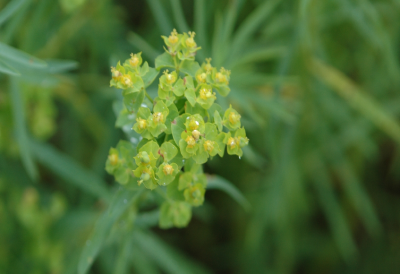Difficulty of Leafy Spurge Control
It is noteworthy that no known chemical can solely eliminate this weed.
The use of Amitrol-T may only control this weed for some time, but the plant may spring up the year after. Banvel helps reduce its growth rate, and this treatment might continuously be effect for some growing seasons. 2, 4-d amine give top growth control for a period which requires a repeat of the application for at least once in its season. For the best result, these chemicals ought to be applied for some years. Yearly treatment is highly recommended until about 90% success is attained, if not, the leafy spurge may resurface.
The snag with herbicides in the control of leafy spurge is the high cost of purchasing these chemicals. Also, the weeds usually grow in places where spray equipment may not be able to reach. However, herbicides are effective when used to complement other control measures.
Leafy Spurge Noxious Weed Management Options
Cultural Control
Leafy spurge can be controlled by the competitive crops, especially in arable land.
Overgrazing weakens grasses, making them unable to compete with weeds; this is also an effective way to reduce its production.
Irrigation may also help to strengthen other grasses, increasing their growth. This increases the competitiveness with leafy spurge.
Biological Control
Goats and sheep are good leafy spurge eaters. A study conducted reveals that leafy spurge may contribute as high as 50% of sheep’s diet. Leafy spurge is most delicious to sheep when the plant is still succulent in early spring, while goats consume leafy spurge at any time.
Pasture rotation may also help to reduce seed production. Where animals eat leafy spurge after the formation of seed, quarantine animals for about a week after which you move them to a leafy spurge free area.
Two insects have proven highly effective in the control of leafy spurge. They are flea beetles; their adult eats the plant leaves while the larvae bore hole on the roots cause greater damage to the plant. The black dot beetle (Aphthona nigriscutis) has been responsible for reducing the population of leafy spurge that grows in open locations with light soils. While the brown dot beetle (Aphthona cyparissiae) destroys leafy spurge on heavier soils and may thrive in dense vegetation, but with well-lightened habitat.
In areas not suitable for the above species of insects, the Leaf Tier moth (Lobesia euphorbiana) may be introduced. The larvae of this insect cause the major damage to the plant while the adults lay eggs on the plant and when these larvae hatch on the leaves, they are folded up around the terminal bud; this automatically stops seed production.
One good thing about the biological control method is the inexpensive cost of and it proffers a long-term solution to the control of leafy spurge: the insects are established once and for all; there is no repeat cost. All you may want to do is to undertake periodic inspection and monitoring of the success achieved and maybe some little maintenance of the land.
Irrespective of the leafy spurge noxious weed management method adopted, there should be an integration of measures to make the infested area productive again. The most important thing in the control of leafy spurge is to empty the source of the root nutrients.
Do you have a leafy Spurge infestation? Need well-trained professionals to help or guide you in controlling/managing the infestation? Request for a quote today or Contact SprayTech, Colorado weed control specialists, at 720-248-0000 to discuss treatment options.


